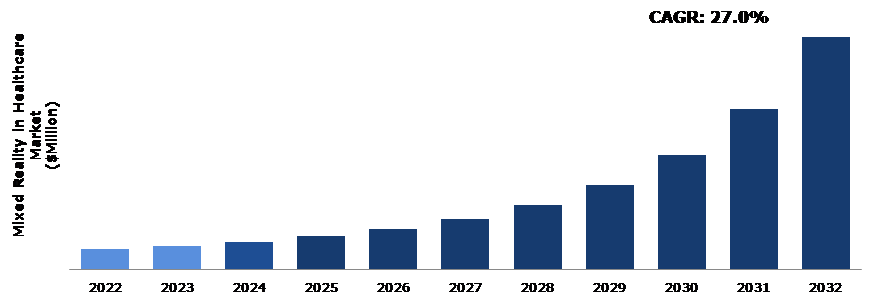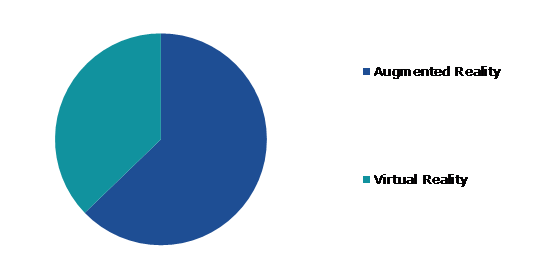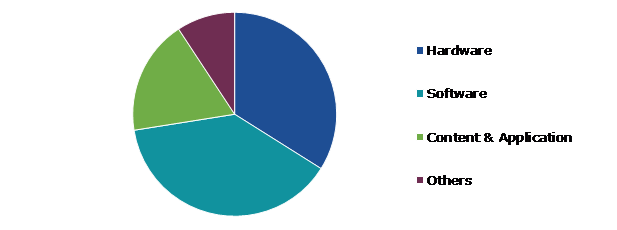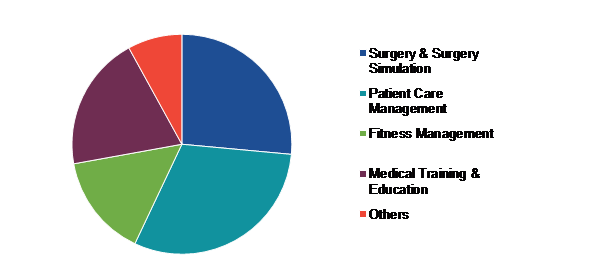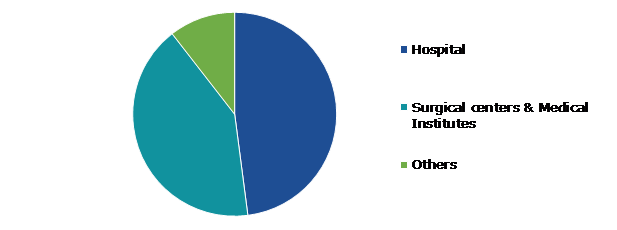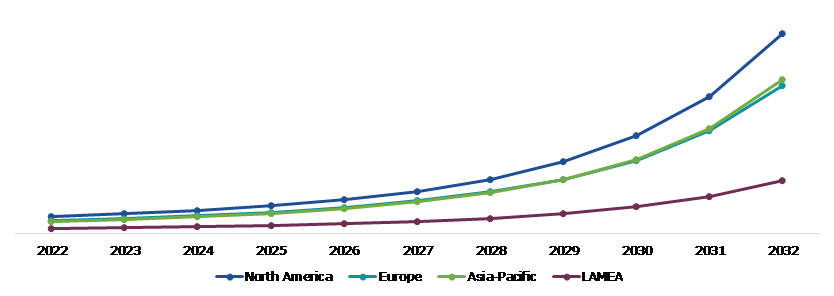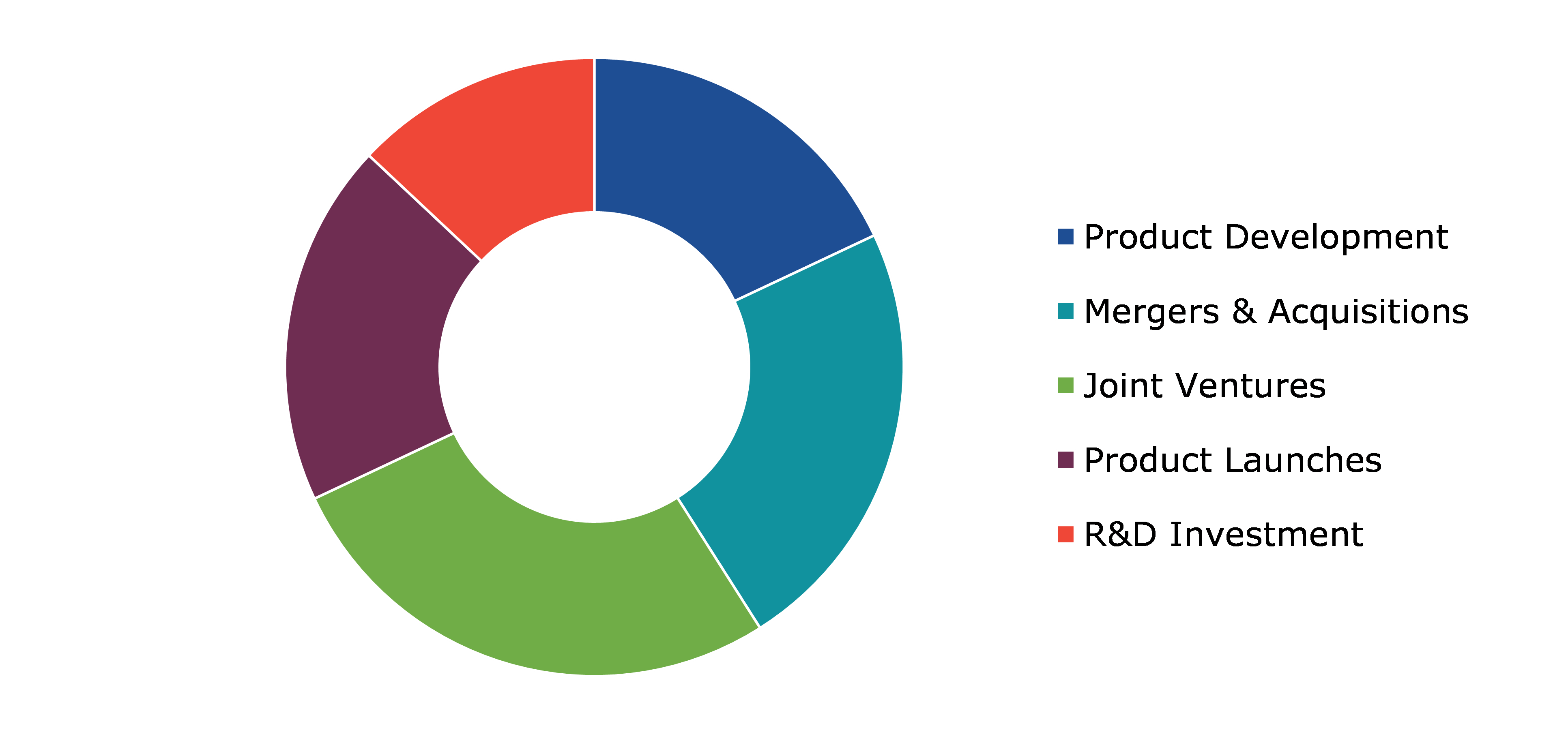Global Mixed Reality In Healthcare Market Report
RA08752
Global Mixed Reality in Healthcare Market by Type (Augmented Reality and Virtual Reality), Component (Hardware, Software, Content & Application, and Others), Application (Surgery & Surgery Simulation, Patient Care Management, Fitness Management, Medical Training & Education, and Others), End User (Hospital, Surgical Centers & Medical Institutes, and Others), and Region (North America, Europe, Asia-Pacific, and LAMEA): Opportunity Analysis and Industry Forecast, 2023-2032
Mixed Reality in Healthcare Overview
Mixed Reality (MR), also known as ‘hybrid reality’ and ‘extended reality,’ has the potential to transform almost every industry, including healthcare. MR is a technology that combines Virtual Reality (VR), Augmented Reality (AR), and Artificial Intelligence (AI) to create experiences that integrate the actual world with digital aspects. It is addressed as revolutionary for its ability to provide a more personalized and immersive experience. Also, recent advancements are opening up previously unimagined possibilities in medicine, not only by lowering training and operational costs, but also by improving surgical safety and precision.
Mixed reality is being used in the healthcare sector to convey important information to operating surgeons via a hands-free interface. Mixed reality helps healthcare providers simplify medical procedures considering the safety of patients. One of the important sectors for the introduction of MR is healthcare, which includes surgical simulation, phobia therapy, robot training, and expert training.
Global Mixed Reality in Healthcare Market Analysis
The global mixed reality in healthcare market size was $2,700.00 million in 2022 and is predicted to grow with a CAGR of 27.0%, by generating a revenue of $30,603.80 million by 2032.
Source: Research Dive Analysis
COVID-19 Impact on Global Mixed Reality in Healthcare Market
The COVID-19 pandemic had a significant impact on the mixed reality in healthcare market. During the pandemic, the need for virtual reality products in the healthcare sector increased. The use of virtual reality in healthcare allowed doctors to better understand and research the impact of the new viral strain. Virtual reality in healthcare has also assisted medical personnel in obtaining real-time radiographic insights, demonstrating the impact of disease on patients' bodies. Most patients who recovered from the COVID-19 infection developed Post-Intensive Care Syndrome (PICS). In this case, virtual reality technology assisted patients in recovering from this syndrome through virtual rehab sessions.
Virtual and augmented reality played a critical role in efficiently managing the global pandemic situation. AR and VR were used for communication in order to treat and raise awareness about COVID-19. During therapy, this technology helped with virtual rehabilitation and pain management for an infected patient. Virtual and augmented reality work together to create a platform that lowers clinicians' face-to-face interactions with infected patients. It contributed to the improvement of the situation's surveillance system through live video broadcasting. The technology of VR and AR is rapidly transforming traditional medical learning and case management techniques.
The advancement of technology in software and hardware systems is lowering costs and improving the user and developer experience. This, in turn, will increase the use of augmented and virtual reality in the post-pandemic period. Key healthcare organizations are increasing their investment in this market to improve patient outcomes, education, and communication.
Increasing Application of VR & AR in Various Treatments to Drive the Market Growth
The healthcare industry is using virtual reality (VR) for immersive visualization. There are numerous applications of VR software that assist medical practitioners in obtaining a multidimensional perspective of medical imaging. This provides them with a complete understanding of a patient's medical state. By merging its evolution into mixed reality, the use of augmented reality in healthcare diagnostics provides the industry with real-time visualization capabilities. For example, MR glasses can be used to overlay digital images on a patient's body, allowing a medical practitioner to undertake real-time analysis. Patients can also use these devices to view their scans in real-time to gain a better understanding of their physical state if necessary. In addition, the creation of a doctor-patient connection is critical in helping to build trust between them. Patients may only trust doctors if they communicate clearly, concisely, and effectively and mixed reality aids in establishing it in a more engaging manner. It enables clinicians to provide detailed explanations to patients in order to improve clarity and understanding. The use of magnetic resonance imaging (MRI) in the healthcare sector reduces response time and increases surgical precision. This eventually leads to a smooth treatment and a positive patient experience.
To know more about global mixed reality in healthcare market drivers, get in touch with our analysts here.
Higher Investment Costs and Technological Issues to Restrain the Market Growth
Higher investment prices, technological challenges, and a lack of knowledge across diverse geographical locations are expected to hamper the expansion of the mixed reality in healthcare market. Implementing mixed reality solutions in place in healthcare necessitates a significant investment in hardware, software, and infrastructure. The cost of manufacturing MR devices, such as headsets and haptic devices, can be substantial, especially when medical-grade quality and compliance standards are considered. Furthermore, the creation of MR applications tailored to specific healthcare demands raises the overall investment expenses. These higher upfront costs may discourage certain healthcare organizations, particularly smaller institutions or those with restricted funds, from implementing mixed reality solutions. These factors are anticipated to restraint the mixed reality in healthcare market size growth in the upcoming years.
Rising Trend of Wearable Technology in Healthcare to Drive Excellent Opportunities
Wearable technology has changed people's perceptions of health and fitness. Wearables are expected to lead the way in the huge technological revolution in the healthcare sector. The integration of virtual reality with wearable gadgets including headsets, goggles, fitness trackers, fitness bands, rings, and others is predicted to speed up the industrial progress. Virtual reality headsets can address mental health problem like depression instantly, helping patients feel safer and comfortable. Wearable devices with virtual reality capabilities will allow patients and doctors to communicate from any location with the aim of analyzing real-time medical insights. These factors are projected to boost market revenue in the future.
To know more about global mixed reality in healthcare market opportunities, get in touch with our analysts here.
Global Mixed Reality in Healthcare Market Share, by Type, 2022
Source: Research Dive Analysis
The augmented reality sub-segment accounted for the highest market share in 2022. The primary drivers driving the growth of market are an increase in the usage of augmented reality in healthcare, an increase in augmented reality investments, an increase in the number of AR startup firms, and an increase in technological advancements. According to a news published in April 2022, augmented reality (AR) is a growing trend in telemedicine, and the introduction of AR into telemedicine has the potential to revolutionize the way doctors and healthcare professionals diagnose and administer appropriate medication. Therefore, rising use of AR in the healthcare sector is expected to boost the segment growth.
Global Mixed Reality in Healthcare Market Size, by Component, 2022
Source: Research Dive Analysis
The software sub-segment accounted for the highest market share in 2022. This growth is due to increased software availability and accessibility for consumers, as well as increased awareness about the use of software platforms for various healthcare reasons. Furthermore, there were recent technological developments in in-app design, including programs like EyeDecide. It assesses numerous characteristics to find eye problems. In addition, patients can reduce their anxiety throughout any surgical operation by using apps like Applied VR. Network services and interconnectivity have advanced significantly in recent years, enabling patients to access these platforms. The market expansion is anticipated to be driven by manufacturers' increasing launches and investments in order to satisfy the rising demand for cutting-edge products. For instance, in March 2021, Applied raised $35 million in Series A funding, which would be used to fund the company's ongoing work on creating software for an immersive headset that will benefit people who suffer from chronic pain. During the forecast period, these initiatives are anticipated to accelerate the market expansion.
Global Mixed Reality in Healthcare Market Analysis, by Application, 2022
Source: Research Dive Analysis
The patient care management sub-segment accounted for the highest market share in 2022, as there is a rising need for new technology to improve patient satisfaction. In addition, factors like increased patient referrals for patient care management and rising prevalence of critical medical illnesses like cancer are anticipated to boost the market expansion during the forecast years. The mixed reality technology can provide a detailed three-dimensional representation of the patient's physical system, important metrics such as heart rate and blood pressure, and allow surgeons to confer with experts located elsewhere. This configuration provides surgeons with unparalleled levels of detail, allowing them to make more informed judgements during surgery. The use of mixed reality in these applications has the potential to improve the success rate of complex procedures.
Global Mixed Reality in Healthcare Market Growth, by End User, 2022
Source: Research Dive Analysis
The hospital sub-segment accounted for the highest market share in 2022. This is due to the increasing use of mixed reality-based technology for improved patient care management. In addition, the rising use of mixed reality technology for pain management, mental health, and other applications is driving the mixed reality in healthcare market growth. This is due to the growing use of virtual reality in hospitals. Hospitals and clinics are overburdened with patients, and the rise in chronic diseases is driving the use of modern technology. Furthermore, there is a growth in the number of patients with chronic conditions, as well as a rising desire for better patient outcomes. Technological innovations assist healthcare facilities in increasing service quality by allowing them to provide care at a lesser cost and in a more efficient manner.
Global Mixed Reality in Healthcare Market Size & Forecast, by Region, 2022-2032 ($Million)
Source: Research Dive Analysis
The North America mixed reality in healthcare market generated the highest revenue in 2022. VR adoption is increasing in this region owing to the growing use of immersive technologies in medical practices. Other reasons driving the regional market growth include government initiatives and considerable R&D spending. Furthermore, the U.S. government is funding research on VR applications in the healthcare sector. Due to rising demand to cut treatment costs, healthcare providers are outsourcing healthcare-related IT services. These factors are also predicted to boost the mixed reality in healthcare market demand. Some of the other factors driving market expansion in North America include the increase in prevalence of psychiatric and neurological illnesses, technological advancements linked to mixed reality products and services, and the existence of several market players in the region. Furthermore, government support for the use of these technologies in the medical industry to reduce training costs and improve training and education programs is expected to drive the North America mixed reality in healthcare market expansion even further.
Competitive Scenario in the Global Mixed Reality in Healthcare Market
Investment and agreement are common strategies followed by major market players. In May 2020, Augmedix became public after a reverse merger with Malo Holdings. On October 5, 2020, a subsidiary of the Malo Holdings merged with Augmedix, allowing it to begin trading over the counter on the OTCQB.
Source: Research Dive Analysis
Some of the leading mixed reality in healthcare market players are Daqri, EchoPixel, Inc., Oculus VR, Atheer, Inc., Firsthand Technology, Inc., Osso VR, Surgical Theater, Inc., Microsoft Corporation, Samsung Electronics Co. Ltd., and HTC Corporation.
| Aspect | Particulars |
| Historical Market Estimations | 2020-2021 |
| Base Year for Market Estimation | 2022 |
| Forecast Timeline for Market Projection | 2023-2032 |
| Geographical Scope | North America, Europe, Asia-Pacific, and LAMEA |
| Segmentation by Type |
|
| Segmentation by Component |
|
|
Segmentation by Application
|
|
|
Segmentation by End User
|
|
| Key Companies Profiled |
|
Q1. What is the size of the global mixed reality in healthcare market?
A. The size of the global mixed reality in healthcare market was over $2,700.00 million in 2022 and is projected to reach $30,603.80 million by 2032.
Q2. Which are the major companies in the mixed reality in healthcare market?
A. Osso VR, Surgical Theater, Inc., Microsoft Corporation, and Samsung Electronics Co. Ltd. are some of the key players in the global mixed reality in healthcare market.
Q3. Which region, among others, possesses greater investment opportunities in the future?
A. Asia-Pacific possesses great investment opportunities for investors in the future.
Q4. What will be the growth rate of the Asia-Pacific mixed reality in healthcare market?
A. Asia-Pacific mixed reality in healthcare market is anticipated to grow at 28.2% CAGR during the forecast period.
Q5. What are the strategies opted by the leading players in this market?
A. Agreement and investment are the two key strategies opted by the operating companies in this market.
Q6. Which companies are investing more on R&D practices?
A. Daqri, EchoPixel, Inc., Oculus VR, Atheer, Inc., and Firsthand Technology, Inc., are the companies investing more on R&D activities for developing new products and technologies.
1.Research Methodology
1.1.Desk Research
1.2.Real time insights and validation
1.3.Forecast model
1.4.Assumptions and forecast parameters
1.5.Market size estimation
1.5.1.Top-down approach
1.5.2.Bottom-up approach
2.Report Scope
2.1.Market definition
2.2.Key objectives of the study
2.3.Report overview
2.4.Market segmentation
2.5.Overview of the impact of COVID-19 on Global Mixed Reality in Healthcare Market
3.Executive Summary
4.Market Overview
4.1.Introduction
4.2.Growth impact forces
4.2.1.Drivers
4.2.2.Restraints
4.2.3.Opportunities
4.3.Market value chain analysis
4.3.1.List of raw material suppliers
4.3.2.List of manufacturers
4.3.3.List of distributors
4.4.Innovation & sustainability matrices
4.4.1.Technology matrix
4.4.2.Regulatory matrix
4.5.Porter’s five forces analysis
4.5.1.Bargaining power of suppliers
4.5.2.Bargaining power of consumers
4.5.3.Threat of substitutes
4.5.4.Threat of new entrants
4.5.5.Competitive rivalry intensity
4.6.PESTLE analysis
4.6.1.Political
4.6.2.Economical
4.6.3.Social
4.6.4.Technological
4.6.5.Environmental
4.7.Impact of COVID-19 on Mixed Reality in Healthcare Market
4.7.1.Pre-covid market scenario
4.7.2.Post-covid market scenario
5.Mixed Reality in Healthcare Market Analysis, by Type
5.1.Overview
5.2.Augmented Reality
5.2.1.Definition, key trends, growth factors, and opportunities
5.2.2.Market size analysis, by region, 2022-2032
5.2.3.Market share analysis, by country, 2022-2032
5.3.Virtual Reality
5.3.1.Definition, key trends, growth factors, and opportunities
5.3.2.Market size analysis, by region, 2022-2032
5.3.3.Market share analysis, by country, 2022-2032
5.4.Research Dive Exclusive Insights
5.4.1.Market attractiveness
5.4.2.Competition heatmap
6.Mixed Reality in Healthcare Market Analysis, by Component
6.1.Hardware
6.1.1.Definition, key trends, growth factors, and opportunities
6.1.2.Market size analysis, by region, 2022-2032
6.1.3.Market share analysis, by country, 2022-2032
6.2.Software
6.2.1.Definition, key trends, growth factors, and opportunities
6.2.2.Market size analysis, by region, 2022-2032
6.2.3.Market share analysis, by country, 2022-2032
6.3.Content & Application
6.3.1.Definition, key trends, growth factors, and opportunities
6.3.2.Market size analysis, by region, 2022-2032
6.3.3.Market share analysis, by country, 2022-2032
6.4.Others
6.4.1.Definition, key trends, growth factors, and opportunities
6.4.2.Market size analysis, by region, 2022-2032
6.4.3.Market share analysis, by country, 2022-2032
6.5.Research Dive Exclusive Insights
6.5.1.Market attractiveness
6.5.2.Competition heatmap
7.Mixed Reality in Healthcare Market Analysis, by Application
7.1.Surgery & Surgery Simulation
7.1.1.Definition, key trends, growth factors, and opportunities
7.1.2.Market size analysis, by region, 2022-2032
7.1.3.Market share analysis, by country, 2022-2032
7.2.Patient Care Management
7.2.1.Definition, key trends, growth factors, and opportunities
7.2.2.Market size analysis, by region, 2022-2032
7.2.3.Market share analysis, by country, 2022-2032
7.3.Fitness Management
7.3.1.Definition, key trends, growth factors, and opportunities
7.3.2.Market size analysis, by region, 2022-2032
7.3.3.Market share analysis, by country, 2022-2032
7.4.Medical Training & Education
7.4.1.Definition, key trends, growth factors, and opportunities
7.4.2.Market size analysis, by region, 2022-2032
7.4.3.Market share analysis, by country, 2022-2032
7.5.Others
7.5.1.Definition, key trends, growth factors, and opportunities
7.5.2.Market size analysis, by region, 2022-2032
7.5.3.Market share analysis, by country, 2022-2032
7.6.Research Dive Exclusive Insights
7.6.1.Market attractiveness
7.6.2.Competition heatmap
8.Mixed Reality in Healthcare Market Analysis, by Ens User
8.1.Hospital
8.1.1.Definition, key trends, growth factors, and opportunities
8.1.2.Market size analysis, by region, 2022-2032
8.1.3.Market share analysis, by country, 2022-2032
8.2.Surgical Centers & Medical Institutes
8.2.1.Definition, key trends, growth factors, and opportunities
8.2.2.Market size analysis, by region, 2022-2032
8.2.3.Market share analysis, by country, 2022-2032
8.3.Others
8.3.1.Definition, key trends, growth factors, and opportunities
8.3.2.Market size analysis, by region, 2022-2032
8.3.3.Market share analysis, by country, 2022-2032
8.4.Research Dive Exclusive Insights
8.4.1.Market attractiveness
8.4.2.Competition heatmap
9.Mixed Reality in Healthcare Market, by Region
9.1.North America
9.1.1.U.S.
9.1.1.1.Market size analysis, by Type, 2022-2032
9.1.1.2.Market size analysis, by Component, 2022-2032
9.1.1.3.Market size analysis, by Application, 2022-2032
9.1.1.4.Market size analysis, by End User, 2022-2032
9.1.2.Canada
9.1.2.1.Market size analysis, by Type, 2022-2032
9.1.2.2.Market size analysis, by Component, 2022-2032
9.1.2.3.Market size analysis, by Application, 2022-2032
9.1.2.4.Market size analysis, by End User, 2022-2032
9.1.3.Mexico
9.1.3.1.Market size analysis, by Type, 2022-2032
9.1.3.2.Market size analysis, by Component, 2022-2032
9.1.3.3.Market size analysis, by Application, 2022-2032
9.1.3.4.Market size analysis, by End User, 2022-2032
9.1.4.Research Dive Exclusive Insights
9.1.4.1.Market attractiveness
9.1.4.2.Competition heatmap
9.2.Europe
9.2.1.Germany
9.2.1.1.Market size analysis, by Type, 2022-2032
9.2.1.2.Market size analysis, by Component, 2022-2032
9.2.1.3.Market size analysis, by Application, 2022-2032
9.2.1.4.Market size analysis, by End User, 2022-2032
9.2.2.UK
9.2.2.1.Market size analysis, by Type, 2022-2032
9.2.2.2.Market size analysis, by Component, 2022-2032
9.2.2.3.Market size analysis, by Application, 2022-2032
9.2.2.4.Market size analysis, by End User, 2022-2032
9.2.3.France
9.2.3.1.Market size analysis, by Type, 2022-2032
9.2.3.2.Market size analysis, by Component, 2022-2032
9.2.3.3.Market size analysis, by Application, 2022-2032
9.2.3.4.Market size analysis, by End User, 2022-2032
9.2.4.Spain
9.2.4.1.Market size analysis, by Type, 2022-2032
9.2.4.2.Market size analysis, by Component, 2022-2032
9.2.4.3.Market size analysis, by Application, 2022-2032
9.2.4.4.Market size analysis, by End User, 2022-2032
9.2.5.Italy
9.2.5.1.Market size analysis, by Type, 2022-2032
9.2.5.2.Market size analysis, by Component, 2022-2032
9.2.5.3.Market size analysis, by Application, 2022-2032
9.2.5.4.Market size analysis, by End User, 2022-2032
9.2.6.Rest of Europe
9.2.6.1.Market size analysis, by Type, 2022-2032
9.2.6.2.Market size analysis, by Component, 2022-2032
9.2.6.3.Market size analysis, by Application, 2022-2032
9.2.6.4.Market size analysis, by End User, 2022-2032
9.2.7.Research Dive Exclusive Insights
9.2.7.1.Market attractiveness
9.2.7.2.Competition heatmap
9.3.Asia-Pacific
9.3.1.China
9.3.1.1.Market size analysis, by Type, 2022-2032
9.3.1.2.Market size analysis, by Component, 2022-2032
9.3.1.3.Market size analysis, by Application, 2022-2032
9.3.1.4.Market size analysis, by End User, 2022-2032
9.3.2.Japan
9.3.2.1.Market size analysis, by Type, 2022-2032
9.3.2.2.Market size analysis, by Component, 2022-2032
9.3.2.3.Market size analysis, by Application, 2022-2032
9.3.2.4.Market size analysis, by End User, 2022-2032
9.3.3.India
9.3.3.1.Market size analysis, by Type, 2022-2032
9.3.3.2.Market size analysis, by Component, 2022-2032
9.3.3.3.Market size analysis, by Application, 2022-2032
9.3.3.4.Market size analysis, by End User, 2022-2032
9.3.4.Australia
9.3.4.1.Market size analysis, by Type, 2022-2032
9.3.4.2.Market size analysis, by Component, 2022-2032
9.3.4.3.Market size analysis, by Application, 2022-2032
9.3.4.4.Market size analysis, by End User, 2022-2032
9.3.5.South Korea
9.3.5.1.Market size analysis, by Type, 2022-2032
9.3.5.2.Market size analysis, by Component, 2022-2032
9.3.5.3.Market size analysis, by Application, 2022-2032
9.3.5.4.Market size analysis, by End User, 2022-2032
9.3.6.Rest of Asia-Pacific
9.3.6.1.Market size analysis, by Type, 2022-2032
9.3.6.2.Market size analysis, by Component, 2022-2032
9.3.6.3.Market size analysis, by Application, 2022-2032
9.3.6.4.Market size analysis, by End User, 2022-2032
9.3.7.Research Dive Exclusive Insights
9.3.7.1.Market attractiveness
9.3.7.2.Competition heatmap
9.4.LAMEA
9.4.1.Brazil
9.4.1.1.Market size analysis, by Type, 2022-2032
9.4.1.2.Market size analysis, by Component, 2022-2032
9.4.1.3.Market size analysis, by Application, 2022-2032
9.4.1.4.Market size analysis, by End User, 2022-2032
9.4.2.Saudi Arabia
9.4.2.1.Market size analysis, by Type, 2022-2032
9.4.2.2.Market size analysis, by Component, 2022-2032
9.4.2.3.Market size analysis, by Application, 2022-2032
9.4.2.4.Market size analysis, by End User, 2022-2032
9.4.3.UAE
9.4.3.1.Market size analysis, by Type, 2022-2032
9.4.3.2.Market size analysis, by Component, 2022-2032
9.4.3.3.Market size analysis, by Application, 2022-2032
9.4.3.4.Market size analysis, by End User, 2022-2032
9.4.4.South Africa
9.4.4.1.Market size analysis, by Type, 2022-2032
9.4.4.2.Market size analysis, by Component, 2022-2032
9.4.4.3.Market size analysis, by Application, 2022-2032
9.4.4.4.Market size analysis, by End User, 2022-2032
9.4.5.Rest of LAMEA
9.4.5.1.Market size analysis, by Type, 2022-2032
9.4.5.2.Market size analysis, by Component, 2022-2032
9.4.5.3.Market size analysis, by Application, 2022-2032
9.4.5.4.Market size analysis, by End User, 2022-2032
9.4.6.Research Dive Exclusive Insights
9.4.6.1.Market attractiveness
9.4.6.2.Competition heatmap
10.Competitive Landscape
10.1.Top winning strategies, 2022
10.1.1.By strategy
10.1.2.By year
10.2.Strategic overview
10.3.Market share analysis, 2022
11.Company Profiles
11.1.Daqri
11.1.1.Overview
11.1.2.Business segments
11.1.3.Product portfolio
11.1.4.Financial performance
11.1.5.Recent developments
11.1.6.SWOT analysis
11.2.EchoPixel, Inc.
11.2.1.Overview
11.2.2.Business segments
11.2.3.Product portfolio
11.2.4.Financial performance
11.2.5.Recent developments
11.2.6.SWOT analysis
11.3.Oculus VR
11.3.1.Overview
11.3.2.Business segments
11.3.3.Product portfolio
11.3.4.Financial performance
11.3.5.Recent developments
11.3.6.SWOT analysis
11.4.Atheer, Inc.
11.4.1.Overview
11.4.2.Business segments
11.4.3.Product portfolio
11.4.4.Financial performance
11.4.5.Recent developments
11.4.6.SWOT analysis
11.5.Osso VR
11.5.1.Overview
11.5.2.Business segments
11.5.3.Product portfolio
11.5.4.Financial performance
11.5.5.Recent developments
11.5.6.SWOT analysis
11.6.Surgical Theater, Inc.
11.6.1.Overview
11.6.2.Business segments
11.6.3.Product portfolio
11.6.4.Financial performance
11.6.5.Recent developments
11.6.6.SWOT analysis
11.7.Microsoft Corporation
11.7.1.Overview
11.7.2.Business segments
11.7.3.Product portfolio
11.7.4.Financial performance
11.7.5.Recent developments
11.7.6.SWOT analysis
11.8.Samsung Electronics Co. Ltd.
11.8.1.Overview
11.8.2.Business segments
11.8.3.Product portfolio
11.8.4.Financial performance
11.8.5.Recent developments
11.8.6.SWOT analysis
11.9.HTC Corporation.
11.9.1.Overview
11.9.2.Business segments
11.9.3.Product portfolio
11.9.4.Financial performance
11.9.5.Recent developments
11.9.6.SWOT analysis11.10.Firsthand Technology, Inc.
11.10.1.Overview
11.10.2.Business segments
11.10.3.Product portfolio
11.10.4.Financial performance
11.10.5.Recent developments
11.10.6.SWOT analysis
Personalize this research
- Triangulate with your own data
- Request your format and definition
- Get a deeper dive on a specific application, geography, customer or competitor
- + 1-888-961-4454 Toll - Free
- support@researchdive.com

